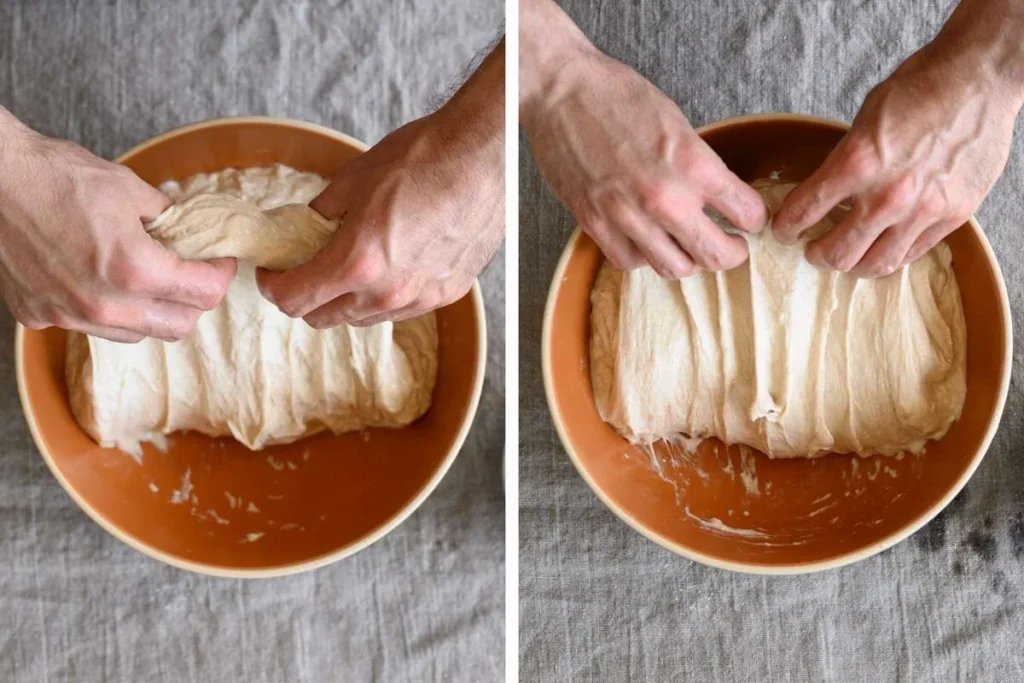
Sourdough Bread Techniques: Stretch and Fold vs Kneading
Sourdough bread is a go-to in lots of homes and bakeries, known for its crispy outside and tangy taste. What makes it special are two techniques working behind the scenes: Stretch and Fold, vs Kneading.
People who love baking can get pretty heated about which one is better. In this blog post, we’ll get into the nitty-gritty of making sourdough bread, looking at the distinctions between Stretch and Fold and Kneading. This will help you figure out which method fits your taste and how you like to bake.
Table of Contents
ToggleUnderstanding Traditional Kneading
Traditional kneading is a technique that involves repetitively folding, pressing, and turning the dough. This method has been the backbone of bread-making for centuries. However, when it comes to sourdough, the impact of traditional kneading can be both beneficial and limiting.
While traditional kneading strengthens the gluten network in the dough, providing structure and elasticity, it also has its drawbacks. The prolonged process may lead to oxidation, affecting the flavor profile of the sourdough. Additionally, achieving the desired consistency can be challenging for novice bakers.
Advantages and Disadvantages of Kneading
Kneading is a traditional bread-making technique that involves repetitive folding, pressing, and turning of the dough. While it has been a staple in baking for centuries, it comes with its own set of advantages and disadvantages that bakers should consider.
Advantages:
- Gluten Development: Kneading promotes the formation of a strong gluten network, contributing to the structure and elasticity of the dough. This is essential for achieving a well-textured loaf.
- Consistent Texture: The rhythmic motion of kneading helps in achieving a consistent texture throughout the dough. This results in a uniform crumb and a pleasing mouthfeel.
- Improved Bread Volume: Proper kneading allows for better gas retention during fermentation, leading to increased bread volume. This is especially important for achieving a light and airy loaf.
- Traditional Artistry: Kneading embodies the traditional, hands-on approach to bread making. Many bakers find a therapeutic aspect in their physical engagement with the dough, connecting them to the age-old art of baking.
- Suitable for All Doughs: Kneading is versatile and can be applied to various types of dough, including those with different hydration levels or containing mix-ins like nuts and seeds.
Disadvantages:
- Oxidation: The prolonged process of kneading can introduce oxygen to the dough, leading to oxidation. This may affect the flavor profile of the sourdough, potentially resulting in a less nuanced taste.
- Labor-Intensive: Kneading requires physical effort, and for larger batches or those new to baking, it can be labor-intensive. This might be a deterrent for individuals with limited time or physical constraints.
- Time-Consuming: Traditional kneading takes time, and in our fast-paced lives, this might not be practical for everyone. The extended duration might be a challenge for bakers with busy schedules.
- Skill-Dependent: Achieving the perfect knead requires skill and practice. Novice bakers might struggle initially, leading to uneven dough consistency or overworking.
- Potential for Over-Kneading: Over-kneading can result in a dense final product. It requires precision to strike the right balance between developing gluten and avoiding excessive manipulation.

Traditional Sourdough Kneading Technique | Step-By-Step
This step-by-step guide will walk you through the rhythmic process, ensuring your sourdough attains the perfect texture and flavor.
- Step 1: Gather Your Ingredients: Before diving into kneading, ensure you have your sourdough ingredients ready. This typically includes flour, water, salt, and an active sourdough starter.
- Step 2: Mix the Dough: Combine the flour, water, salt, and starter in a large mixing bowl. Use a wooden spoon or your hands to bring the ingredients together until a shaggy dough forms.
- Step 3: Begin Kneading: Transfer the dough onto a lightly floured surface. Start the kneading process by pushing the dough away from you with the heel of your hand. Fold the dough back onto itself, then give it a quarter turn.
- Step 4: Repeat and Rotate: Continue kneading for 10-15 minutes, ensuring a smooth, elastic consistency. If the dough becomes too sticky, sprinkle a bit of flour on the surface. Rotate the dough periodically to ensure even kneading.
- Step 5: Check for Elasticity: To test if the dough is ready, perform the windowpane test. Gently stretch a small piece of dough between your fingers. If it forms a thin, translucent window without tearing, it’s adequately kneaded.
- Step 6: Rest the Dough: Shape the dough into a ball and place it back into the mixing bowl. Cover it with a damp cloth and allow it to rest for the bulk fermentation period specified in your recipe.
What Happens if You Don’t Knead Sourdough Enough?
If you don’t knead your sourdough enough, you risk messing up how it holds together and feels. Kneading is super important because it helps the gluten develop, making the dough strong and stretchy.
If you don’t knead it well, the gluten won’t form properly, and your bread might turn out heavy and not rise well. Plus, it could mess with how the bread tastes and the texture inside.
Getting the right balance when kneading is key to making sure the gluten forms just right, resulting in a light, airy, and tasty sourdough. It’s a crucial step that makes a big difference in how good your bread turns out.

What is Stretch and Folding Sourdough Bread
Stretch and fold is a game-changing technique in making sourdough bread. Instead of the continuous kneading motion, you gently stretch the dough and fold it onto itself at intervals while it’s fermenting.
This method focuses on developing gluten without the strenuous kneading, which creates a more open crumb structure and improves the overall texture of the bread. The stretch and fold technique provides a hands-off and forgiving option, making it easy for bakers of all levels.
Not only does this method simplify the mixing process, but it also gives you better control over fermentation, resulting in a flavorful and well-structured sourdough loaf.
Advantages and Disadvantages of Stretch and Fold
The stretch and fold technique has become quite popular in the world of sourdough for its unique advantages. However, like any method, it has its drawbacks.
Let’s explore the pros and cons of the stretch and fold technique to help you make informed decisions on your sourdough journey.
Advantages:
- 1. Improved Dough Strength: One of the main benefits of stretch and fold is its ability to enhance gluten development. The gentle stretching and folding help create a strong and elastic dough, crucial for achieving a light and well-structured crumb.
- 2. Better Fermentation: The intermittent folding in this technique creates pockets of trapped gas within the dough, creating a favorable environment for fermentation. This results in improved flavor development and a lighter texture in the final loaf.
- 3. Flexible Timing: Stretch and fold is forgiving when it comes to timing. Unlike traditional kneading which requires continuous attention, this technique allows bakers to work around their schedules. It’s accessible for both beginners and experienced bakers with busy lives.
- 4. Open Crumb Structure: Bakers aiming for an open crumb structure in their sourdough loaves often prefer stretch and fold. The technique helps create irregular and large air pockets, adding a desirable texture to the bread.
Disadvantages:
- 1. Requires Practice: While forgiving, the stretch and fold technique still requires practice to master. Striking the right balance between stretching the dough adequately and avoiding overhandling it can be challenging for beginners.
- 2. Potential for Stickiness: Depending on the hydration level of the dough, bakers may encounter stickiness during the stretching and folding process. Managing sticky dough requires finesse and a good understanding of the dough’s consistency.
- 3. Less Physical Interaction: Some bakers enjoy the therapeutic aspect of physically kneading the dough. The stretch and fold technique, being more hands-off, might lack the sensory experience and connection with the dough that traditional kneading provides.

The Sourdough Stretch and Fold Technique | Step-By-Step
Follow these easy steps to nail the sourdough stretch and fold technique, boosting the awesomeness of your homemade bread.
- Step 1: Mix it Up: Grab a big bowl and toss in your flour, water, sourdough starter, and salt. Stir it all together with a spatula or your hands, making sure everything gets mixed well. Let it chill for about 30 minutes, giving the flour time to soak up all the moisture.
- Step 2: Get Stretchy: After that break, wet your hands a bit to avoid sticky situations. Reach under the dough, lift one side, stretch it up, and then fold it back over itself. Do this for all four sides, basically making a folded square.
- Step 3: Time to Chill: Let the dough take a breather for 20-30 minutes. This downtime helps the gluten relax and kicks off the fermentation process. It’s a crucial step for getting that awesome texture and structure in your sourdough.
- Step 4: Stretch and Fold Encore: Do another round of stretching and folding. Wet your hands again and gently repeat the process from the first stretch. You’ll feel the dough getting more elastic as the gluten does its thing.
- Step 5: Keep it Going: Keep up with more stretch and fold cycles during the bulk fermentation stage. The number of folds depends on factors like how wet the dough is and the room temperature. Just roll with it!
How Many Times Should You Stretch and Fold Sourdough?
Figuring out how often to stretch and fold your sourdough dough depends on different things like the recipe, the room temperature, and how the dough is shaping up. Usually, you’ll do this every 30 minutes to an hour while the dough is in the bulk fermentation phase.
Doing this helps make the gluten structure stronger, which leads to a better rise and texture. But, adjust it according to your recipe and what you want in the end. Try different frequencies of folding to figure out what works best for your taste and gets you the crumb structure you want in your sourdough bread.
Comparing the Results of Kneading vs Stretch and Fold Technique
Choosing between kneading and the stretch-and-fold technique is a big deal in the world of making bread. Each method brings its qualities to the final product.
Kneading, a classic and well-known approach, involves repeatedly folding, pressing, and turning the dough. This helps develop gluten, the protein that gives bread its structure and texture. It’s a tried-and-true process that gives you loaves with a distinct crumb and a chewy texture.
On the flip side, the stretch-and-fold technique has become popular for its simplicity and minimal hands-on time. This method takes advantage of the dough’s natural fermentation process, letting gluten and structure develop over a longer period.
Instead of constant handling, the dough gets stretched and folded periodically, resulting in a more open crumb and a lighter texture. This technique is often preferred for its efficiency, especially with high-hydration doughs.
When you compare the results of these two techniques, several factors come into play. The choice between them can significantly affect the texture, taste, and appearance of the final product. Kneaded loaves usually have a tighter crumb structure, giving a hearty bite and a more even texture. In contrast, stretch-and-fold loaves tend to have a more open crumb with uneven air pockets, creating lighter, airier bread.
The flavor of the bread can also be influenced by the chosen technique. The longer fermentation in the stretch-and-fold process allows for more flavor development, resulting in a nuanced and complex taste. Kneading, with its shorter fermentation period, may produce a simpler flavor profile.
In the end, the decision between kneading and stretch-and-fold depends on the characteristics you want in your bread. Whether you stick to the traditional method of kneading or go for the efficiency of stretch and fold, each technique offers a unique path to achieving the perfect loaf.
Stretch and Fold vs Kneading | Conclusion
In the world of making sourdough bread, there’s a heated debate among bakers about whether to stick with the traditional Kneading method or go for the modern Stretch and Fold technique. Both methods come with their pros and cons, affecting how the bread turns out in terms of texture, taste, and looks.
Traditional Kneading has been around forever and is all about strengthening gluten, giving you a well-textured and uniform inside. But, it’s not without its downsides – it might lead to oxidation and can be pretty labor-intensive. On the other hand, Stretch and Fold take a hands-off approach, letting gluten develop gradually, resulting in a more open and lighter texture.
In the end, the choice comes down to personal preference, your baking style, and what you want in your perfect sourdough. Whether you’re into the rhythmic tradition of kneading or prefer the efficiency of stretch and fold, each technique offers a distinct path to achieving that ideal loaf of bread. Happy baking!
Lindsey Mackenzie
About me
Hi there! I’m Lindsey Mackenzie, the founder of Bake Smartly. Baking has been my passion since childhood, growing up in my father’s bakery. With Bake Smartly, I’m excited to share my love for all things sweet and savory. Join me on this delicious journey as we whip up scrumptious treats and sprinkle joy into every bite!






